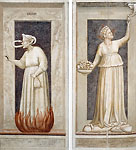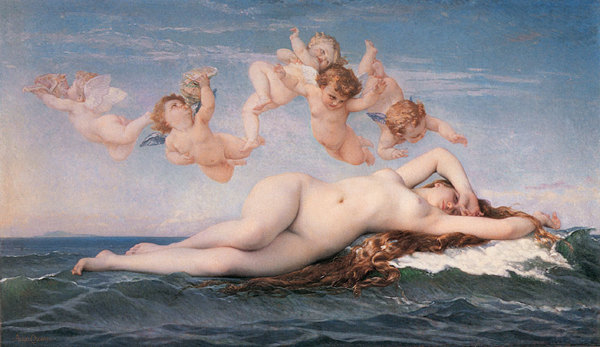
The first thing that I like but that is now dead is The Simpsons.
(This isn’t really going to be ‘about’ The Simpsons in the end, so if you don’t particularly care about The Simpsons just replace “The Simpsons†with “[other popular American TV show]†every time you come across “The Simpsons,†and overall the point of most of this should still make sense.)
The Simpsons is my favorite TV show ever. I have seen every episode like three times, and there are like 500+ episodes. Do the math. I own seasons 1-13 on DVD. I own a ~1,000 pg. hardcover episode guide. I own another shorter paperback episode guide that has mostly the same material as my hardcover episode guide, for no good reason. I have lots of Simpsons comics. I have Simpsons Monopoly. I have Simpsons Clue. I know how to pronounce “Matt Groening.†I was Bart for Halloween once. Etc.
A week or two ago The Simpsons aired its 500th episode. It was really bad. For a hardcore Simpsons fan like myself, it was even depressing. The episode ended with this ‘cute’ tidbit:

Well, you ‘got me,’ Simpsons: I am now talking about how much your 500th episode sucked on the internet. (But I did get some fresh air before writing this—Wednesday was really sunny and warm and I spent most of the day in the arb.) Another ‘cute’ tidbit: note the “the most meaningless milestone of all!†tagline in the first image from the episode’s opening credits.
Without even going into detail about how exactly the 500th episode was bad and unfunny (and it was indeed VERY BAD AND UNFUNNY), just by pointing out these two ‘cute tidbits’—which aren’t really just ‘cute tidbits’ but are in fact a sort of insidious televisual rhetorical sleight of hand (or so I’ll argue in a sec.)—just with that, I can tell you how I know The Simpsons is no longer a legitimate piece of televisual art and is now just a sort of pathetic, desperate, please-like-me-why-don’t-you-like-me…TV…thing.
TV generally gets a bad rap (deservedly, perhaps), but at its best I consider it a ‘legitimate form of art.’ For a while—like seasons 1 through ~12—The Simpsons was one of the best pieces of televisual art. It was the quintessence of ‘sitcom.’ It was the apotheosis of TV. Its writers were basically better, smarter than 51% of the writers I now read as an English-B.A. candidate. I’ve learned more from seasons 1 through ~12 of The Simpsons than from semesters 1 through 6 of my undergraduate education. That might be inaccurate. But I’ve definitely learned more about good writing—like narration, plot, characterization, puns, etc.—from The Simpsons than from any undergrad English class. That’s not hyperbole.
But the way I can now tell, officially, that The Simpsons is dead as a piece of art, that it’s now just a garden-variety bad-rap-getting primetime-TV P.O.S. is that it’s stopped simply funnily dealing with plain-ole’ middle class familial affairs and started inciting a sort of convolved rhetorical game in which it tries to convince you that you’re sort of a P.O.S. for watching The Simpsons (e.g., “get some fresh air why don’t ya!â€) and that The Simpsons is a sort of a P.O.S. itself but that you should laugh ‘with’ it about how much of a P.O.S it is. Or, it’s not really a P.O.S because it knows it is now, at episode 500, a P.O.S. Or something.
What The Simpsons’ cute shots at itself (“Log online! Make fun of us!â€) do, really, is set up a rhetorical situation in which it is impossible for you to simultaneously criticize them seriously and intelligently and for you to remain a serious/intelligent art-viewer/person—it makes these things mutually exclusive. The Simpsons wants it to be impossible for you to hold them accountable for being a P.O.S. (read: w/ double entendre, “point of sale†and “piece of human refuseâ€).
If you think The Simpsons isn’t trying to convince you that it hasn’t turned into a P.O.S. because it is itself ‘candidly admitting’ that it is in fact a meaningless excremental hunk of TV—and even admitting that it knows it’s a meaningless excremental hunk of TV—with cutesy posturing like “most meaningless milestone of all!†and “logging onto the internet and saying how much this episode sucked,†don’t. Don’t let the posturing fool you: these ‘admissions’ of suckiness are Psych101-style reverse-psychology defense mechanisms. They’re rhetorical moves. Most of all, they’re B.S. The Simpsons has turned into, like, that fat kid in fifth grade who made fun of himself so he seemed okay with his being fat and seemed totally not sensitive about it and seemed to totally not care that has friends called him a ‘lard-ass’ everyday but who actually went home everyday feeling terrible and was actually totally sensitive about his weight and cried alone in his room every night while eating ~6 Twinkies and feeling just downright miserable/downright full of Twinkies.
Self-deprecation as a rhetorical move implicitly shields against any real, bona-fide criticism. Think of it this way: If the fat kid calls himself fat and then you call him fat afterwards, your insult loses a lot of its sting, now doesn’t it. It seems pointless. It seems dead-horse-beating-y. You seem like a less intelligent human being for redundantly beating fat dead horses unoriginally redundantly. You seem to lack wit. Likewise, if The Simpsons calls itself sucky before you can log onto the internet and call it sucky, then you’re backed into a sort of rhetorical corner if you want to air some serious criticism. Because The Simpsons has beat you to the punch. Why would you criticize something that’s already been effectively criticized? Sure, you can go ahead and voice your criticism anyway, but the response The Simpsons has set you up to be met with is something like “we all already know The Simpsons is sucky now; even The Simpsons calls The Simpsons sucky now; stop stupidly saying unoriginal things we all already know already, stupid.â€
The Simpsons and the fatty both want to look like pachyderms; they want to look like they don’t care whether you like them/think they’re overweight or not. (Except the fatty probably doesn’t want to look like a pachyderm, in terms of size…) The universal definition of ‘cool’ seems to be something like ‘nonchalance’ or ‘indifference’ or ‘not caring,’ so it’s easy to understand what The Simpsons and elephant-sized kid are going for by affecting anti-/apathy towards themselves and their artistic/cardiovascular health: They want to be liked. They want to be cool. They want to be popular. And to be cool and to be popular, they have to convince you that they don’t particularly care about being cool and being popular.
Why? Because I can guarantee you that your idea of ‘cool’ is somehow related to ‘nonchalance’ or ‘indifference’ or something like that. What’s more cool than someone who doesn’t caring about being ‘cool’? What’s more uncool than someone who seems to live and die by your judgment of them? Ergo if something seems to not care about itself or how you will judge it, you will judge it better. It’s a sort of paradox: the only way to be judged well is to disregard how well you will be judged.
So: in order to be judged well, The Simpsons pretends to not care about being judged unwell.
But of course, The Simpsons truly does care about what their fans think—to drop the personification for a second, let’s acknowledge that what ‘The Simpsons’ is really is a bunch of human beings who probably work hard at their TV jobs and who are probably basically decent people who care about the quality of what they produce and wouldn’t feel good, about themselves as human beings, if they mostly produced televisual excrement. In fact, I know they care because why else would they dare you to criticize them? Think about it—if they didn’t care about being criticized, why would they even bring it up, why add the little endnote? Because they just ‘don’t care’ SO MUCH that they, like, HAVE TO let you know about how much they don’t care? Seems unlikely. There’s a difference between genuine coolness/nonchalance and affected indifference.
When The Simpsons says, “Go ahead; criticize me,†I see not a cool, indifferent piece of bona-fide art but a scared, desperate-to-be-liked prepubescent fatty. I see a sales pitch: “Like me because I’m cool.†“I’m cool because I don’t care if I’m still cool at age 500.†“Being a nerd who posts 1,000+ words online about not liking me instead of going outside or something is nerdy and uncool.†“Watching ‘meaningless’ TV and getting excited about a ‘meaningless milestone’ for your favorite TV show is dumb, RIGHT? *wink**wink*.†Etc. It seems to me that one of the big differences between a piece of bona-fide art and a piece of commercial crap is how much effort the thing apparently devotes to selling itself. The Simpsons used to not need to sell itself. It used to just sell other things—like Butterfingers. But now it’s such a bad show that, instead of convincing people to watch it by being good/funny, it convinces people to watch it by half-assedly reverse-psychologically convincing them not to hate it.
None of this is really only pertinent to one specific episode of The Simpsons, by the way. I just used the 500th episode of The Simpsons for this post because it was temporally and personally relevant. But all TV’s been making fun of itself for decades. E.g. there’s the 80’s Married…With Children, which has been described as “a sitcom-parody of sitcoms†(i.e., a sitcom that makes fun of sitcoms). For another example there’s televisual demigod David Letterman, whose jokes’ butts are usually his show/himself.
I’ve never actually watched Letterman or Married…With Children, because I am less than one-hundred years old, but the point is The Simpsons wasn’t the first TV show to try what I would term ‘the self-deprecating-fat-kid technique.’ Other shows have done it, and have done it better.
The second thing that I like but that is now dead is David Foster Wallace.
David Foster Wallace was an American author. He killed himself not too long ago, sadly. His ‘birthday’ was a couple weeks ago, around the time The Simpsons 500th aired. One of the things David Foster Wallace wrote was an essay about U.S. television and irony, which I’m admittedly pulling ~90% of my ideas from here (not to mention the examples of Married…W/ and Letterman). When I saw The Simpsons pull a ‘self-deprecating-fatty,’ I immediately thought of David Foster Wallace. I thought of Wallace quotations like:
“And make no mistake: irony tyrannizes us. The reason why our pervasive cultural irony is at once so powerful and so unsatisfying is that an ironist is impossible to pin down. All U.S. irony is based on an implicit ‘I don’t really mean what I’m saying.’ So what does irony as a cultural norm mean to say? That it’s impossible to mean what you say? That maybe it’s too bad it’s impossible, but wake up and smell the coffee already? Most likely, I think, today’s irony ends up saying: ‘How totally banal of you to ask what I really mean.'”
And:
“It’s of some interest that the lively arts of the millennial U.S.A. treat anhedonia and internal emptiness as hip and cool. It’s maybe the vestiges of the Romantic glorification of Weltschmerz, which means world-weariness or hip ennui. Maybe it’s the fact that most of the arts here are produced by world-weary and sophisticated older people and then consumed by younger people who not only consume art but study it for clues on how to be cool, hip–and keep in mind that, for kids and younger people, to be hip and cool is the same as to be admired and accepted and included and so Unalone. Forget so-called peer-pressure. It’s more like peer-hunger. No? We enter a spiritual puberty where we snap to the fact that the great transcendent horror is loneliness, excluded encagement in the self. Once we’ve hit this age, we will no give or take anything, wear any masks, to fit, be part-of, not be Alone, we young. The U.S. arts are our guide to inclusion. A how-to. We are shown how to fashion masks of ennui and jaded irony at a young age where the face is fictile enough to assume the shape of whatever it wears. And then it’s stuck there, the weary cynicism that saves us from gooey sentiment and unsophisticated naivete. Sentiment equals naivete on this continent…â€
Those two quotations are two things I really like.








